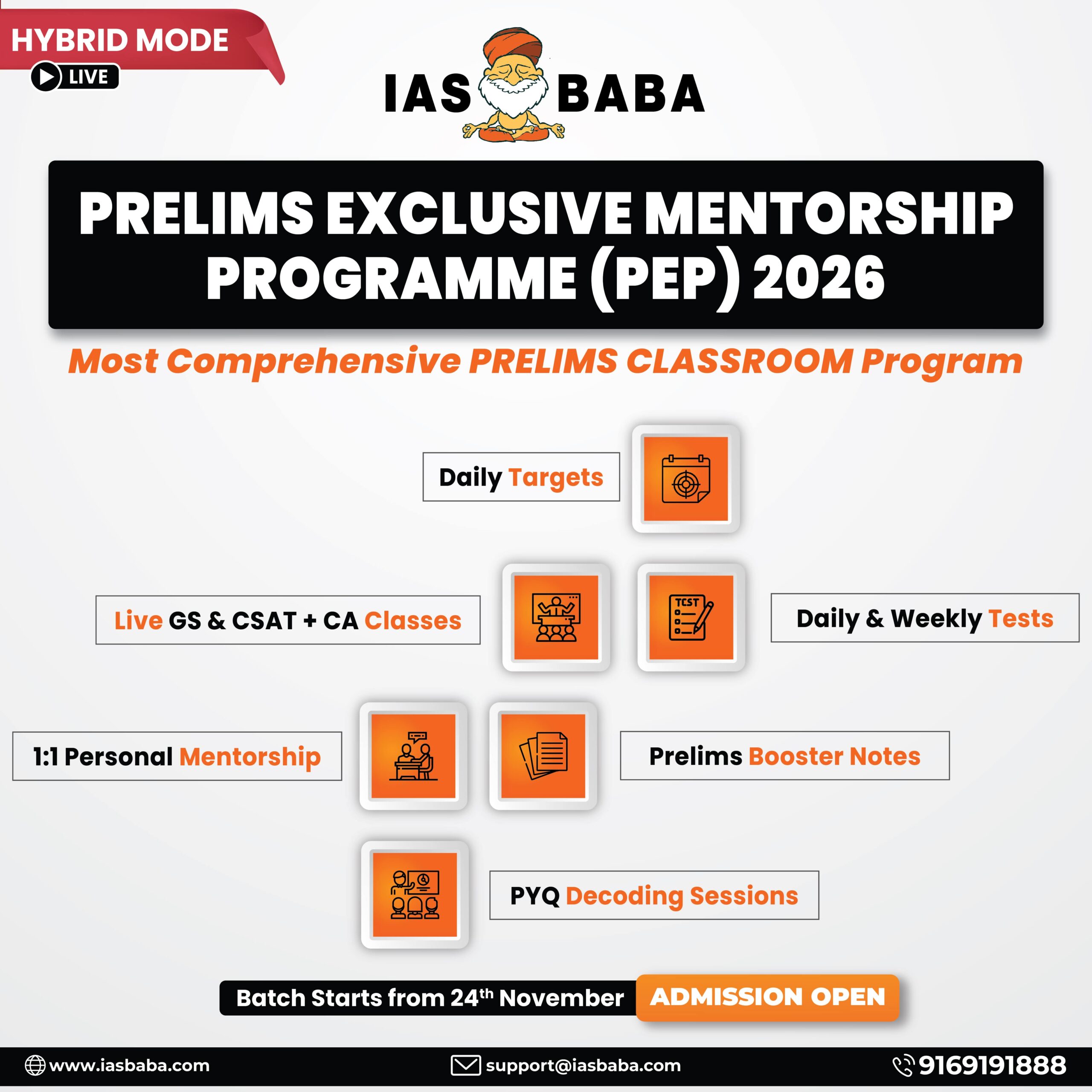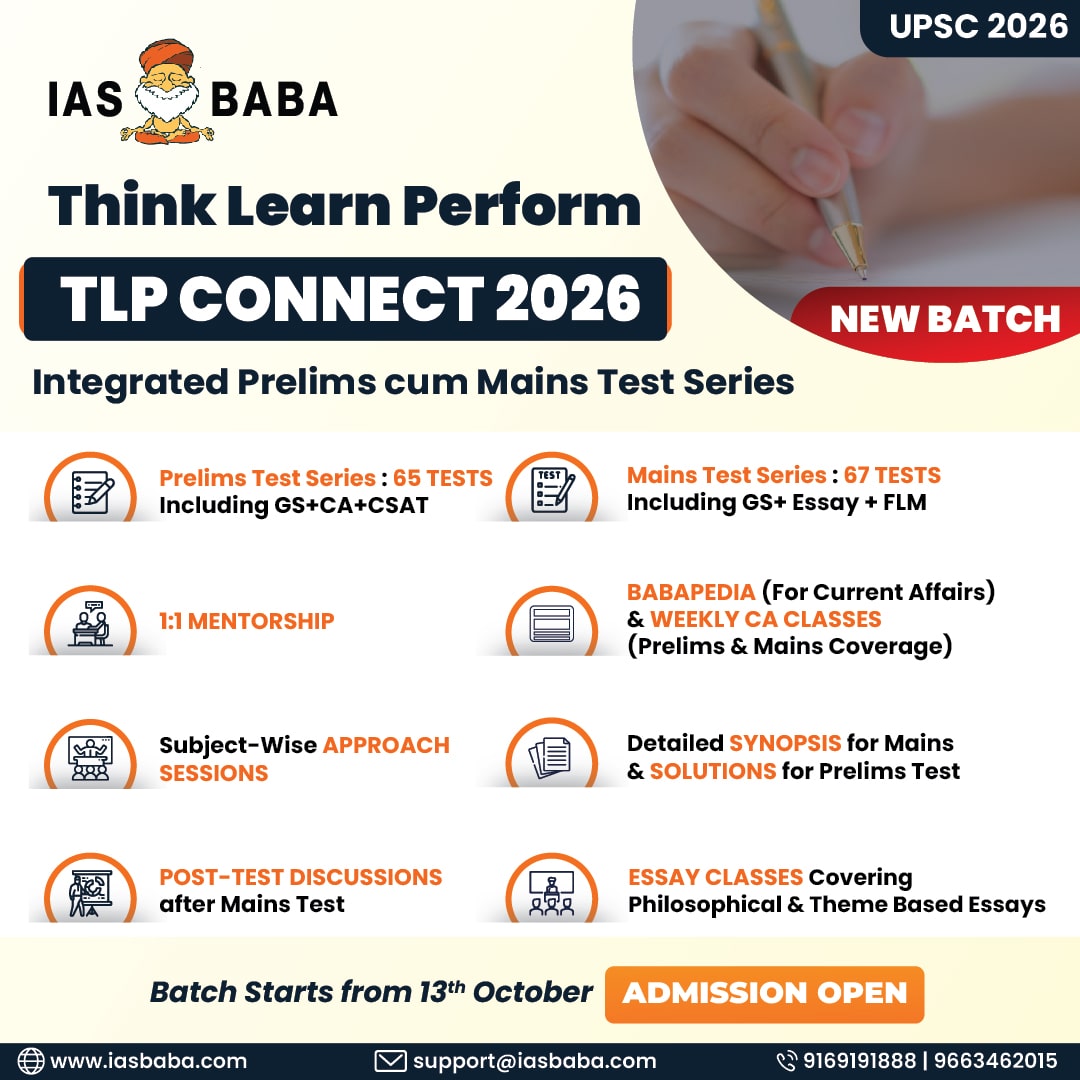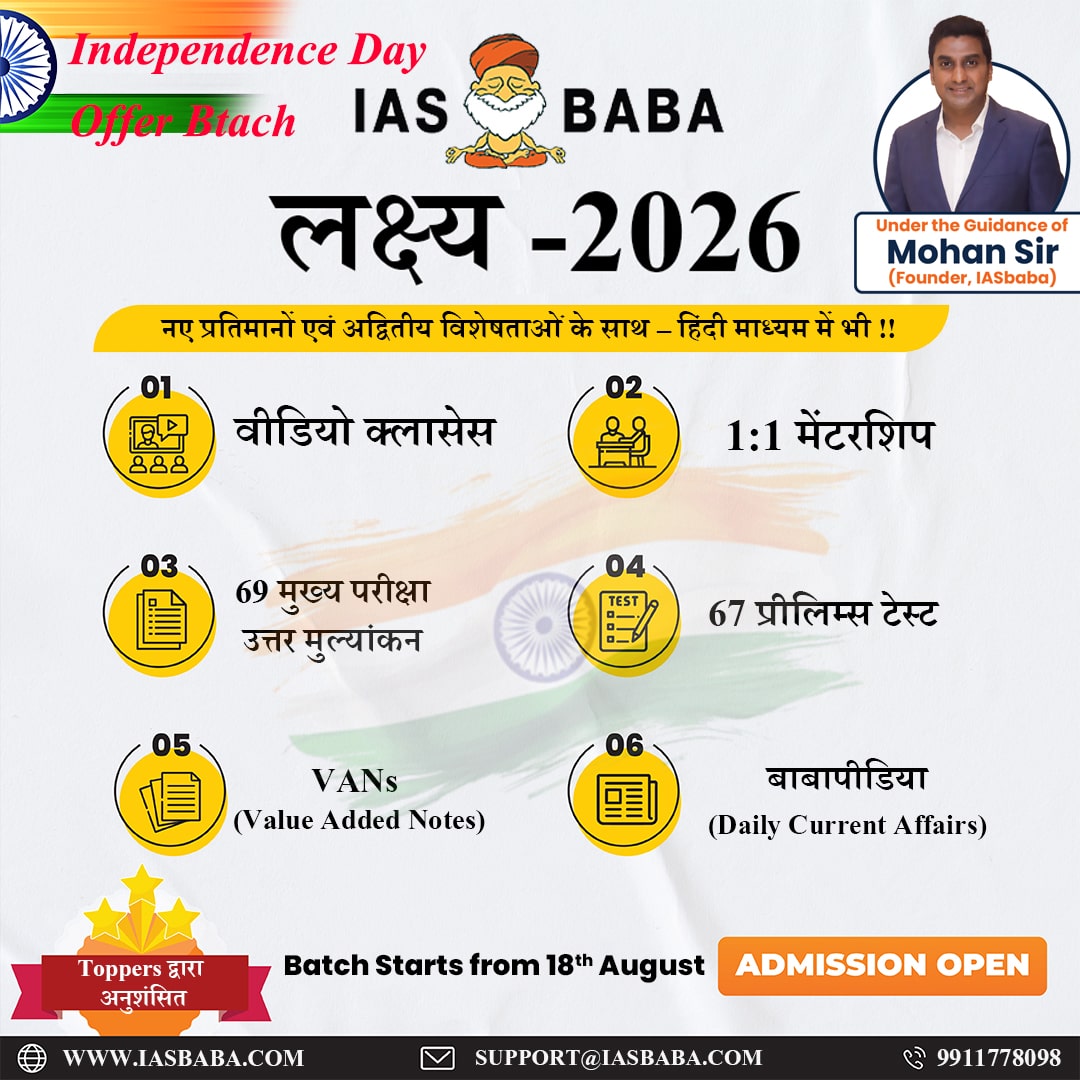IASbaba's Daily Current Affairs Analysis
Archives
(PRELIMS & MAINS Focus)
Category: GEOGRAPHY
Context: Indian Institute of Astrophysics in Bengaluru under the blazing Sun celebrated Zero Shadow Day on 24 April 2024.
Decoding the context: IIA institute is an autonomous research institution under the Department of Science and Technology of Government of India.
Learning Corner:
- Zero Shadow Day is a celestial event during which no shadow is cast by any object standing upright on the ground at solar noon.
- It occurs twice a year for places located between the Tropic of Cancer (23.5°N) and Tropic of Capricorn (23.5°S)—i.e., the tropical zone. Regions outside the tropics never experience ZSD.
- On this day, the Sun is exactly overhead at noon (i.e., the solar declination equals the latitude of the location).
Mechanism and Timing
- Due to the tilt of the Earth’s axis (23.5°), the Sun appears to move north and south of the equator during the year (called apparent motion of the Sun).
- As the Sun moves between the tropics, it passes directly overhead at specific latitudes:
- Uttarayana (April-May): Sun moves north; ZSD occurs in southern India (e.g., Bengaluru, 12.97°N, on April 24, 2025).
- Dakshinayana (August-September): Sun moves south; ZSD occurs again (e.g., Bengaluru on August 18, 2025).
- Places on the Equator get Zero Shadow Day on equinoxes (March 21 & Sept 23).
Source : PIB
Category: ENVIRONMENT
Context: Dr. K. Kasturirangan, the former chairman of the Indian Space Research Organisation (ISRO) and a key figure in shaping India’s National Education Policy (NEP), passed away in Bengaluru. He chaired the high-level working group on Western Ghats that was constituted by the union environment ministry.
Decoding the context: Awarded the Padma Vibhushan, the country’s second highest civilian award, he was the fourth chairman of ISRO.
Learning Corner:
- The High-Level Working Group (HLWG) on the Western Ghats, chaired by Dr. K. Kasturirangan, was constituted in August 2012. This 10-member panel was tasked with reviewing the Western Ghats Ecology Expert Panel (WGEEP) report, also known as the Gadgil Report (2011), which faced opposition for its stringent recommendations.
- Objective: To balance environmental conservation with developmental needs in the Western Ghats, a UNESCO World Heritage Site and one of the world’s eight “hottest hotspots” of biodiversity, spanning 1,64,280 sq km across six states—Gujarat, Maharashtra, Goa, Karnataka, Kerala, and Tamil Nadu.
Key Recommendations (Report Submitted: April 15, 2013)
- Ecologically Sensitive Area (ESA): Recommended 37% of the Western Ghats (60,000 sq km) as ESA, a significant reduction from the Gadgil Report’s 64% (77,000 sq km). Used satellite data (24 m resolution) for precise mapping.
- Zoning: Divided the Ghats into:
- Natural Landscape: Characterized by high biological richness, ESA protection, and restrictions on activities like mining and large townships
- Cultural Landscape: Areas with human settlements, agriculture, and plantations, excluded from stringent regulations to support livelihoods.
- Activity Categories:
- Red Category: Banned mining, thermal plants, and large construction projects in ESA.
- Orange Category: Regulated activities like food processing with minimal environmental impact.
- Green Category: Permitted agriculture, horticulture, and sustainable commercial activities.
Comparison with Gadgil Report
- WGEEP (Gadgil Report): Proposed 64% of the Ghats as ESA, with three Ecologically Sensitive Zones (ESZ 1, 2, 3). Banned most developmental activities in ESZ 1, advocated for decentralized governance via gram sabhas, and prohibited GM crops, plastic bags, and new hill stations.
- Kasturirangan Report: Reduced ESA coverage to 37%, excluding high-density populated areas to address socio-economic concerns. However, it was criticized for relying on remote sensing without ground assessments, leading to errors in zoning.
Source : Hindustan Times
Category: SCIENCE & TECHNOLOGY
Context: Indigenously developed (Human papillomavirus) HPV test kits for cervical cancer screening were launched recently.
Decoding the context: The test kits have been developed under the Department of Biotechnology’s (DBT) partnership programme Grand Challenges India (GCI) at the Biotechnology Industry Research Assistance Council (BIRAC).
Learning Corner:
- Human Papillomavirus (HPV) is a group of over 200 related viruses, with more than 40 types transmitted through sexual contact, making it the most common sexually transmitted infection globally.
- High-risk HPV types are linked to cancers, particularly cervical cancer, while low-risk types cause genital warts and benign lesions.
- India’s HPV vaccine (Cervavac, launched 2023 by Serum Institute) uptake remains low (priced at ₹200-400/dose), with only 1% of eligible girls vaccinated by 2025 due to hesitancy and access issues.
Health Impact in India
- Cervical Cancer Burden: Cervical cancer, primarily caused by HPV (90% correlation), is the second most common cancer among Indian women, with 1,23,000 new cases and 77,000 deaths annually (WHO, 2025).
- India accounts for 25% of global cervical cancer cases and deaths, often due to late diagnosis.
- Other Cancers: HPV also causes anal, vulvar, vaginal, penile, and oropharyngeal cancers, though cervical cancer remains the most prevalent in India.
- Prevalence: Over 80% of sexually active individuals contract HPV at some point, but most infections clear naturally within two years. Persistent infections with high-risk types lead to cancer.
Recent Development (April 2025)
- On April 23, 2025, India launched its first indigenously developed HPV test kits for cervical cancer screening.
- Kits detect eight high-risk HPV genotypes, responsible for over 96% of cervical cancer cases.
- Features: RT-PCR-based, point-of-care, rapid (results within an hour), battery-operated, and cost-effective compared to imported kits.
Source : The Hindu
Category: GOVERNMENT SCHEMES
Context: Madhya Pradesh has received formal approval for the ₹2,100 crore PM Mega Integrated Textile Region and Apparel (PM MITRA) Park project.
Decoding the context: The project has been sanctioned by the Union Ministry of Textiles and will be the first integrated textile park of its kind in India. The PM MITRA Park will feature several modern facilities, including a 20 MLD Zero Liquid Discharge (ZLD) plant, a solar-powered energy facility, and plug-and-play Built-To-Suit (BTS) units.
Learning Corner:
- Launched in 2021 by the Ministry of Textiles, the PM MITRA Scheme aims to establish seven mega textile parks across India to enhance the textile sector’s global competitiveness, inspired by PM Narendra Modi’s 5F vision: Farm to Fibre to Factory to Fashion to Foreign.
Key Objectives
- Integrated Textile Value Chain: Establishing parks that consolidate all stages of textile production—spinning, weaving, dyeing, processing, printing, and garment manufacturing—within a single location to enhance efficiency and reduce logistics costs.
- Infrastructure Development: Creating world-class industrial infrastructure to attract cutting-edge technology, boost foreign direct investment (FDI), and encourage local investment in the textile sector.
- Employment Generation: Each park is expected to generate approximately 1 lakh direct and 2 lakh indirect employment opportunities, contributing significantly to job creation in the sector.
Key Features
- Scale and Location: Each park requires a contiguous, encumbrance-free land parcel of 1,000+ acres. Seven sites approved in Tamil Nadu, Telangana, Karnataka, Gujarat, Maharashtra, Madhya Pradesh, and Uttar Pradesh.
- Out of the seven parks, four are Greenfield projects (Tamil Nadu, Gujarat, Karnataka, Madhya Pradesh) and three are Brownfield projects (Maharashtra, Telangana, Uttar Pradesh).
- An SPV owned by Centre and State Government will be set up for each park which will oversee the implementation of the project.
- The Ministry of Textiles will provide financial support in the form of Development Capital Support upto Rs. 500 crore per park to the Park SPV.
- A Competitive Incentive Support (CIS) upto Rs 300 crore per park to the units in PM MITRA Park shall also be provided to incentivise speedy implementation.
Overall Significance
- Economic Growth: India, the 6th largest textile exporter (4% global share), aims to reach $100 billion in exports by 2030. PM MITRA parks are projected to attract ₹70,000 crore in investments and create 20 lakh jobs (1 lakh direct, 2 lakh indirect per park).
- Global Competitiveness: Aligns with free trade agreements (e.g., UAE, Australia) to access developed markets, reducing dependence on imports (e.g., Chinese knitted fabric).
- Policy Alignment: Supports Make in India and SDG 9 (Industry, Innovation, Infrastructure) by fostering world-class infrastructure and FDI.
Source : Economic Times
Category: SCIENCE & TECHNOLOGY
Context: In a significant step towards the development of the next-generation station hypersonic missiles, India has successfully carried out a ground test of the Scramjet engine for more than 1,000 seconds.
Decoding the context: Defence Research & Development Laboratory (DRDL), a Hyderabad-based laboratory of the Defence Research and Development Organisation (DRDO) achieved this significant milestone in the field of Hypersonic Weapon Technology.
Learning Corner:
- A Supersonic Combustion Ramjet (Scramjet) is an air-breathing engine designed for hypersonic speeds (above Mach 5, or 6,100 kmph), where traditional jet engines falter.
- Unlike ramjets, which slow airflow to subsonic speeds before combustion, scramjets sustain supersonic airflow throughout the combustion process.
- Key components: Inlet, combustor (with fuel injector and flame holder), and nozzle.
- Scramjets lack moving parts, relying on the vehicle’s forward motion to compress air, making them lightweight but challenging to design due to extreme heat (over 2,000°C) and combustion stability issues.
| Feature | Turbojet | Ramjet | Scramjet |
| Speed Range | Subsonic to ~Mach 3 | Mach 2 to Mach 5 | Mach 5 to Mach 15 |
| Combustion Speed | Subsonic | Subsonic | Supersonic |
| Moving Parts | Has compressor/turbine | No moving parts | No moving parts |
| Atmospheric Oxygen Use | Yes | Yes | Yes |
| Startup Capability | Can start from rest | Needs initial thrust (e.g., booster) | Needs higher initial thrust (e.g., rocket booster) |
| Efficiency at High Speed | Low | Medium | High |
Strategic Significance
- Scramjets enable hypersonic cruise missiles that can travel > Mach 5, making them:
- Extremely fast
- Hard to intercept by existing missile defense systems
- Capable of maneuverability, unlike ballistic missiles.
- Global Race: The US, Russia (Zircon missile), and China (DF-ZF glider) lead hypersonic development.
- Applications: Beyond missiles, scramjets can enable cost-effective space launches by using atmospheric oxygen, reducing the need for onboard oxidizers.
Source : India Today
Practice MCQs
Q1.With reference to air-breathing propulsion technologies, consider the following statements:
- A scramjet engine allows combustion of fuel in supersonic airflow.
- Unlike rockets, scramjet engines do not carry oxidizers onboard.
- Scramjet engines can operate efficiently from standstill to hypersonic speeds.
Which of the statements given above is/are correct?
A. 1 and 2 only
B. 2 and 3 only
C. 1 and 3 only
D. 1, 2 and 3
Q2.With reference to the PM Mega Integrated Textile Region and Apparel (PM MITRA) scheme, consider the following statements:
- Each PM MITRA park requires a minimum of 1,000 acres of contiguous and encumbrance-free land.
- The implementation of PM MITRA parks is through a Special Purpose Vehicle (SPV) with equal equity participation from the central and state governments.
- The PM MITRA scheme aims to integrate the entire textile value chain at a single location.
Which of the statements given above are correct?
A. 1 and 2 only
B. 2 and 3 only
C. 1 and 3 only
D. 1, 2, and 3
Q3.With reference to Human Papillomavirus (HPV), consider the following statements:
- HPV infection is a cause of cervical cancer, with high-risk strains accounting for the majority of cases.
- India launched its first indigenously developed HPV vaccine, Cervavac, in 2023.
- The recently launched HPV test kits in India are based on RT-PCR technology and can provide results within one hour.
- The World Health Organization recommends HPV vaccination for boys and girls aged 5–9 years to eliminate cervical cancer.
Which of the statements given above are correct?
A. 1 and 2 only
B. 1, 2 and 3 only
C. 1, 3 and 4 only
D. 2 and 4 only
Comment the answers to the above questions in the comment section below!!
ANSWERS FOR ’ Today’s – Daily Practice MCQs’ will be updated along with tomorrow’s Daily Current Affairs
ANSWERS FOR 24th April – Daily Practice MCQs
Q.1) – a
Q.2) – a
Q.3) – a













